AMD Athlon 64 FX-57: The Fastest Single Core
by Derek Wilson on June 27, 2005 11:47 AM EST- Posted in
- CPUs
Workstation Applications
SPECviewperf 8SPECviewperf is a collection of application traces taken from some of the most popular professional applications, and compiled together in a single set of benchmarks used to estimate performance in the various applications in which the benchmark is used to model. With version 8, SPEC has significantly improved the quality of the benchmark, making it even more of a real world indicator of performance.
We have included SPEC's official description of each one of the 8 tests in the suite.
3dsmax Viewset (3dsmax-03)
"The 3dsmax-03 viewset was created from traces of the graphics workload generated by 3ds max 3.1. To insure a common comparison point, the OpenGL plug-in driver from Discreet was used during tracing.
The models for this viewset came from the SPECapc 3ds max 3.1 benchmark. Each model was measured with two different lighting models to reflect a range of potential 3ds max users. The high-complexity model uses five to seven positional lights as defined by the SPECapc benchmark and reflects how a high-end user would work with 3ds max. The medium-complexity lighting models uses two positional lights, a more common lighting environment.
The viewset is based on a trace of the running application and includes all the state changes found during normal 3ds max operation. Immediate-mode OpenGL calls are used to transfer data to the graphics subsystem."
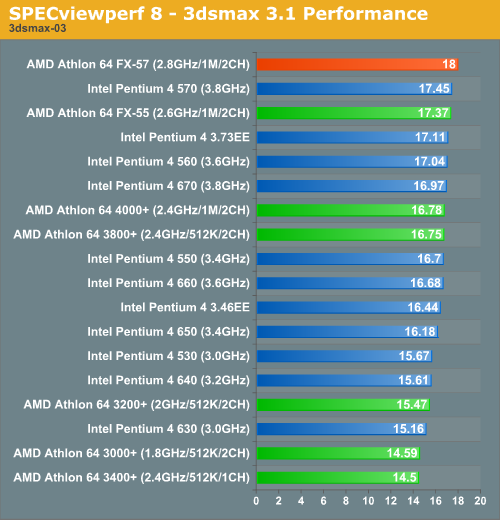
CATIA Viewset (catia-01)
"The catia-01 viewset was created from traces of the graphics workload generated by the CATIATM V5R12 application from Dassault Systems.
Three models are measured using various modes in CATIA. Phil Harris of LionHeart Solutions, developer of CATBench2003, supplied SPEC/GPC with the models used to measure the CATIA application. The models are courtesy of CATBench2003 and CATIA Community.
The car model contains more than two million points. SPECviewperf replicates the geometry represented by the smaller engine block and submarine models to increase complexity and decrease frame rates. After replication, these models contain 1.2 million vertices (engine block) and 1.8 million vertices (submarine).
State changes as made by the application are included throughout the rendering of the model, including matrix, material, light and line-stipple changes. All state changes are derived from a trace of the running application. The state changes put considerably more stress on graphics subsystems than the simple geometry dumps found in older SPECviewperf viewsets.
Mirroring the application, draw arrays are used for some tests and immediate mode used for others."
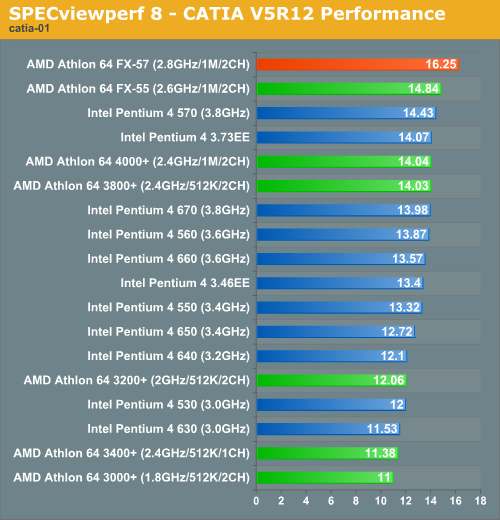
Lightscape Viewset (light-07)
"The light-07 viewset was created from traces of the graphics workload generated by the Lightscape Visualization System from Discreet Logic. Lightscape combines proprietary radiosity algorithms with a physically based lighting interface.
The most significant feature of Lightscape is its ability to accurately simulate global illumination effects by precalculating the diffuse energy distribution in an environment and storing the lighting distribution as part of the 3D model. The resulting lighting "mesh" can then be rapidly displayed."
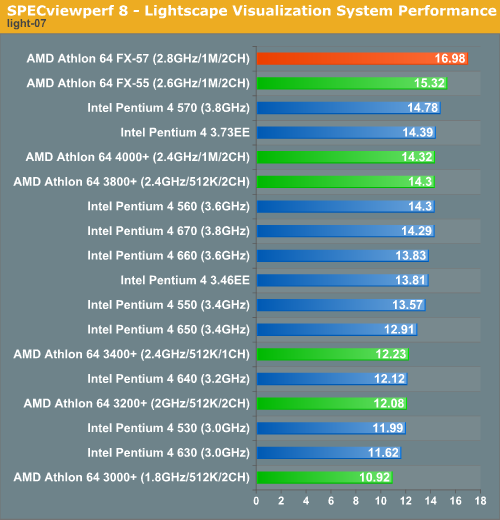
Maya Viewset (maya-01)
"The maya-01 viewset was created from traces of the graphics workload generated by the Maya V5 application from Alias.
The models used in the tests were contributed by artists at NVIDIA. Various modes in the Maya application are measured.
State changes as made by the application are included throughout the rendering of the model, including matrix, material, light and line-stipple changes. All state changes are derived from a trace of the running application. The state changes put considerably more stress on graphics subsystems than the simple geometry dumps found in older viewsets.
As in the Maya V5 application, array element is used to transfer data through the OpenGL API."

Pro/ENGINEER (proe-03)
"The proe-03 viewset was created from traces of the graphics workload generated by the Pro/ENGINEER 2001TM application from PTC.
Two models and three rendering modes are measured during the test. PTC contributed the models to SPEC for use in measurement of the Pro/ENGINEER application. The first of the models, the PTC World Car, represents a large-model workload composed of 3.9 to 5.9 million vertices. This model is measured in shaded, hidden-line removal, and wireframe modes. The wireframe workloads are measured both in normal and antialiased mode. The second model is a copier. It is a medium-sized model made up of 485,000 to 1.6 million vertices. Shaded and hidden-line-removal modes were measured for this model.
This viewset includes state changes as made by the application throughout the rendering of the model, including matrix, material, light and line-stipple changes. The PTC World Car shaded frames include more than 100MB of state and vertex information per frame. All state changes are derived from a trace of the running application. The state changes put considerably more stress on graphics subsystems than the simple geometry dumps found in older viewsets.
Mirroring the application, draw arrays are used for the shaded tests and immediate mode is used for the wireframe. The gradient background used by the Pro/E application is also included to better model the application workload."
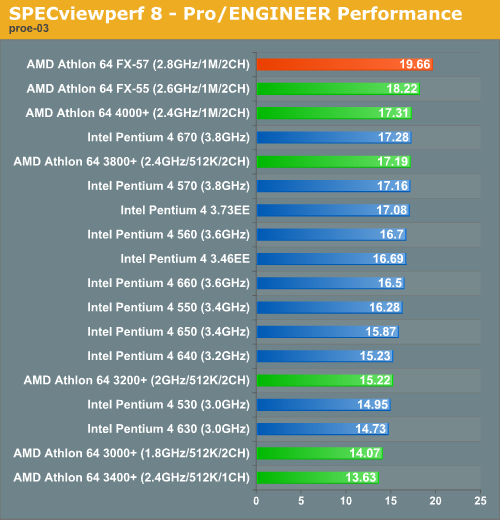
SolidWorks Viewset (sw-01)
"The sw-01 viewset was created from traces of the graphics workload generated by the Solidworks 2004 application from Dassault Systemes.
The model and workloads used were contributed by Solidworks as part of the SPECapc for SolidWorks 2004 benchmark.
State changes as made by the application are included throughout the rendering of the model, including matrix, material, light and line-stipple changes. All state changes are derived from a trace of the running application. The state changes put considerably more stress on graphics subsystems than the simple geometry dumps found in older viewsets.
Mirroring the application, draw arrays are used for some tests and immediate mode used for others."
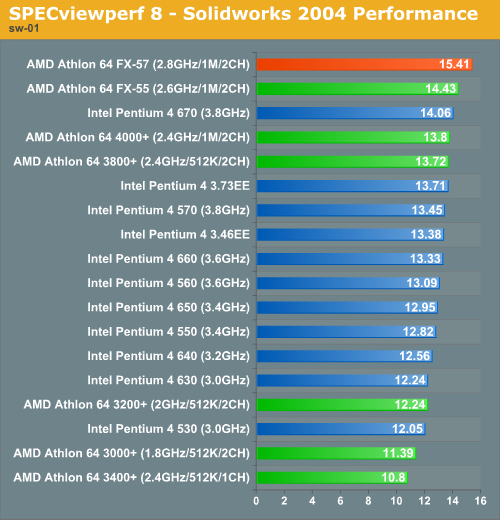
Unigraphics (ugs-04)
"The ugs-04 viewset was created from traces of the graphics workload generated by Unigraphics V17.
The engine model used was taken from the SPECapc for Unigraphics V17 application benchmark. Three rendering modes are measured -- shaded, shaded with transparency, and wireframe. The wireframe workloads are measured both in normal and anti-alised mode. All tests are repeated twice, rotating once in the center of the screen and then moving about the frame to measure clipping performance.
The viewset is based on a trace of the running application and includes all the state changes found during normal Unigraphics operation. As with the application, OpenGL display lists are used to transfer data to the graphics subsystem. Thousands of display lists of varying sizes go into generating each frame of the model.
To increase model size and complexity, SPECviewperf 8.0 replicates the model two times more than the previous ugs-03 test."
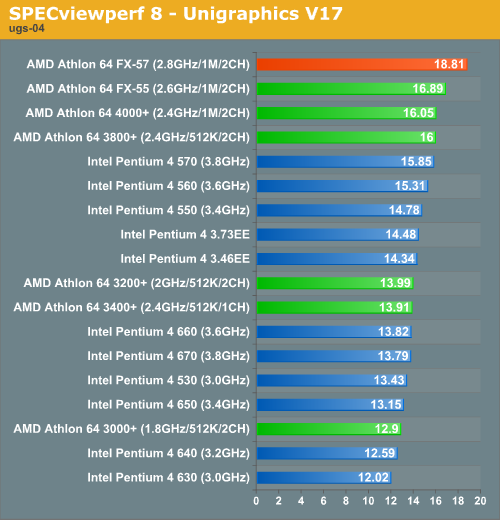










56 Comments
View All Comments
cryptonomicon - Monday, June 27, 2005 - link
what a beastsaratoga - Monday, June 27, 2005 - link
The 533 vs. 400 would make an interesting benchmark. Given the availability of relatively low latency 533 (or at least 500), it might be worthwhile for people who must have the best performance (most FX buyers I'd guess).dougSF30 - Monday, June 27, 2005 - link
> Who is being realistic here?Hello? As you said *in your own post*, anyone splashing out $1000 for an FX-57 can afford to buy top-end memory for it.
Otherwise, what's the point? DDR-333 is really cheap these days, maybe they should test with that?
Viditor - Monday, June 27, 2005 - link
I have a feeling that the mobo AT used was a poor choice...I have checked all of the other reviews I could find, and every one of them that overclocked was able to be stable at 3.0 GHz on air...
Goi - Monday, June 27, 2005 - link
I would've liked a bit more analysis rather than just describing the tests and displaying the results. I notice that this has become more or less an AT template in reviews, with little analysis and a lot of data. I think a bit more analysis on interesting points would be helpful. For example, the 200MHz bump from the FX-55 to the FX-57 causes disproportionate performance increases in certain benchmarks. An detailed analysis on why(going from the 130nm hammer core to the 90nm Venice core with improved memory controller for example) would be helpful I think. There's just too much numbers and not enough analysis IMHO.Viditor - Monday, June 27, 2005 - link
blckgrffn - I understand your point, but this is a Dream Machine chip anyway, so we should definately see it at it's best (latest mobo, DDR533 LL, etc...).JMHO
miketheidiot - Monday, June 27, 2005 - link
this new memory controller has me thinking ddr2....blckgrffn - Monday, June 27, 2005 - link
For those of you who want DDR500 etc included, I don't think that you understand how/why these articles are written. I can appreciate that you want the whole platform to be about the best performance, but then we would lose all sense of just how much better this CPU is compared to the old ones.So, LL DDR500 performs awesome. Great. I suppose if you are buying a $1000 processor you will probably drop $250 on a gig of ram. Super. But for the rest of us, getting ram that runs 2-2-2-10 is hard enough, let alone trying for that super duper ram that runs in how many mobos due to voltage requirements? One or two? Who is being realistic here?
suryad - Monday, June 27, 2005 - link
Looks like if AMD had some sort of HT scheme like Intel did...there would be no benchmark where the Intel would be ahead...but I am most impressed that AMD has now taken over the domain of multimedia and encoding and so on from Intel...cant wait for 3 ghz multicore FX procs!dougSF30 - Monday, June 27, 2005 - link
Dear Lord! Low latency DDR-500 or DDR-533 will peform better than low latency DDR-400!